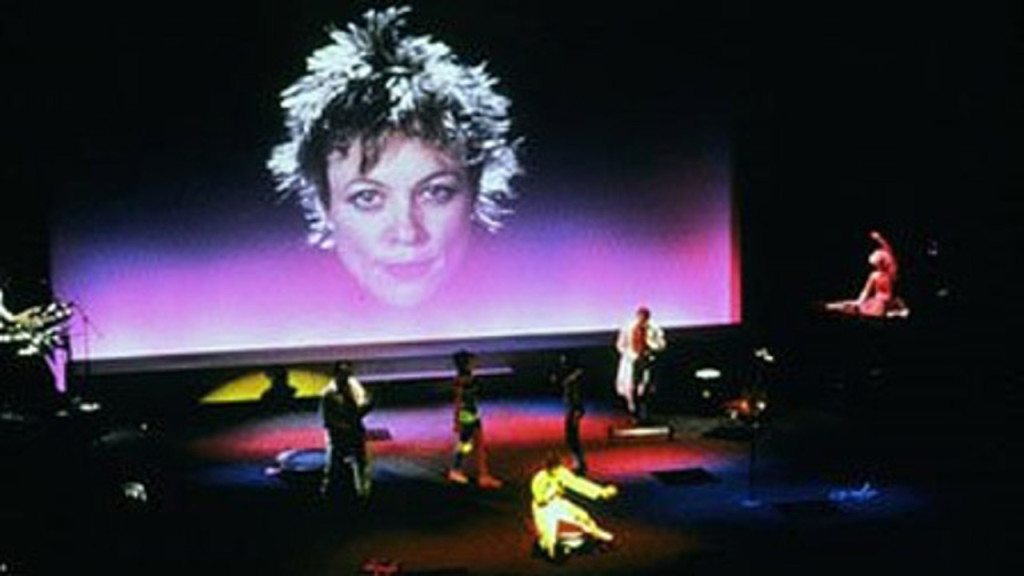VOGUE
O, Superwoman
by Tracy Young on April 15, 1984

People are talking about… What’s news/What’s coming
Toward the end of Laurie Anderson’s concert movie Home of the Brave , a big video screen flashes “notes” she’s written to herself. One is about standing on a corner in SoHo and overhearing someone remark: “Oh, no, another Laurie Anderson clone.”
With her electric chick haircut and a propensity for men’s white suits with skinny ties, Anderson may not be a household word, but she’s definitely a neighborhood “look.” Even before she was no more widely known than the psychic parameters of Lower Manhattan, Laurie Anderson was the performance artist who separated the men from the boys. Her daring musical experiments, with synthesizers, Vocoders, and other gadgets that allowed her to distort her voice and “play” her head and her white woman’s version of break dancing taught the boys a few tricks as well. She exerted a definite influence over such brainy “art” bands as the Talking Heads.
Like David Byrne, the Talking Heads’ acknowledged genius, Anderson was always interested in the visual potential of a music performance—her concerts were distinguished by the clever use of newsreel footage, minimal graphics, and other homespun visual puns. A concert film was as logical a next step for her as it was for the Talking Heads, whose film Stop Making Sense was a huge critical success.
But here the comparison ends. Home of the Brave makes Stop Making Sense look, well, mingy. Anderson, who is credited for writing, directing, and visuals, has made more than a concert film—she’s created a kind of gorgeous technological paradise. The songs here, most of which are from her albums, are beefed up with the help from musicians like David Van Tiegham (the astounding percussionist who’s worked with Twyla Tharp), guitarist Adrian Belew, and the wonderfully deadpan keyboardist Joy Askew, who with her bleached hair and skinny zippered shift dress makes a terrific femme foil for the androgynous Anderson. And all of this super musicianship is blasted out of an apocalyptic sound system.
The film’s stunning visual imagery ranges from elegant computer graphics to wonderfully idiosyncratic costumes designed by Susan Hilferty. There are jumpsuits, Mexican hats, masks that resemble something Woody Allen wore in Sleeper , leotards that make Anderson’s backup singers look like space-age Supremes; and, at one point, Anderson herself wears a slinky, metallic sheath with her traditional white high-tops. Best of all, the camera work doesn’t stop with panoramic sweeps of the often-crowded set (dozens of players are involved at one time or another) but relentlessly picks out the telling and usually humorous detail—William Burroughs doing a kind of tango with Anderson, or a musician clobbering a rubbernecked guitar with a mallet.
Running the whole show, seeming totally at home in her role as a sci-fi Orpheus, is Anderson, whose loose-limbed dancing and sonic scat singing are strangely beguiling. (Her finest moment is a number she plays on her own well-miked body, thupping elbows and knees like a human hurdy-gurdy.) If Home of the Bravesounds too arty for words, it’s not. The most compelling aspect of the film is how much fun everyone seems to be having.
The FM radio success of Anderson’s single “O, Superman” made her perhaps the first crossover performance artist, a spiritual heir to Lily Tomlin, who always was a performance artist and only now seems to have realized it. With Home of the Brave , Anderson seems destined to move even farther from the sophisticates who made her a hit at the Brooklyn Academy of Music and into the arms of a wider audience, weaned on MTV and Miami Vice , hungry for something more satisfying.